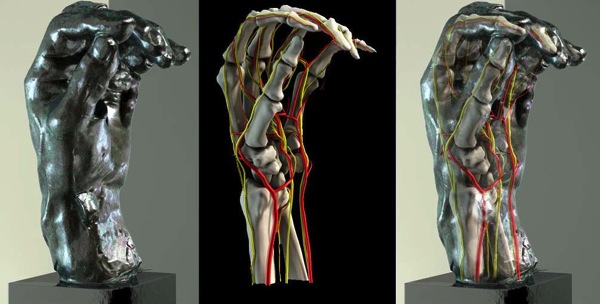
Stanford Goes Hands-On with Rodins

Stanford University surgeon Dr. James Chang is fascinated by Rodin’s hands. He has developed and is teaching a course titled “Surgical Anatomy of the Hand: From Rodin to Reconstruction” in which he combines 3D scans of the sculpture with medical imaging of human bones, nerves, and blood vessels. Currently Stanford’s Iris and B. Gerald Cantor Center for the Arts is featuring a collaboration between Dr. Chang and its Curator of European Art, Bernard Barryte. Inside Rodin’s Hands: Art, Technology, and Surgery, on view at the museum until August 3, explores Rodin’s hands as art and as science.
In the exhibition Chang and his students describe the medical conditions that inform each of the hands. Rodin was fascinated by the expressive capacity of hands and he often exhibited them apart from the rest of the body. Although art scholars have long been interested in the medical issues of some of Rodin’s hands, this is the fist exhibition to address them from a medical point of view and using modern technology. The Rodin artworks are complemented by photographs of patients’ hands who have various conditions ranging from ganglion cysts to thumb amputation to fractures, and by medical texts and illustrations from the 16th to 19th centuries. The exhibition also uses today’s digital technology to further reveal the information in the sculpture.
“I wanted to participate in this exhibition for the same reason I introduced Rodin into my seminar: to get students in the humanities excited about the sciences, and to get doctors to step out of the hospital to appreciate art,” Chang says. “I have found that artists and surgeons appreciate human anatomy with equal passion.”





No Comments